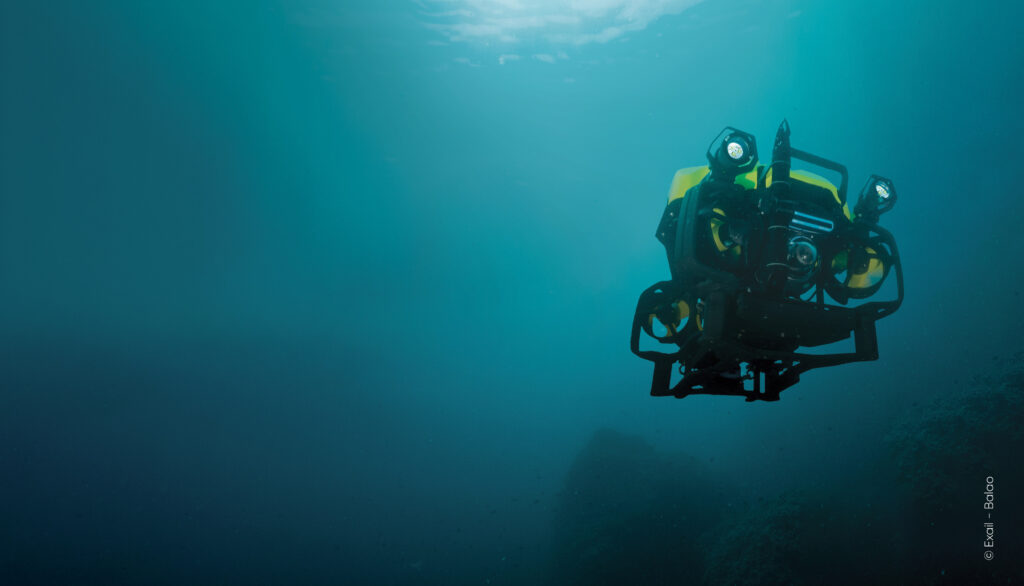R7 Compact ROV : Redefining observation and inspection.

This new ROV from Exail brings together the best of digital technologies to meet the challenges of modern military operations.
Today, several services such as military navies, special forces, coast guards, customs agencies, rescue services, and police departments are looking for a compact, versatile, user-friendly system for their missions. The R7 has been designed to meet these requirements. Despite its compact size, the R7 can fulfill a wide range of missions, such as: search and rescue, black box recovery, retrieval of objects for investigative purposes, assistance to divers, detection, identification, and depollution of unexploded ordnance (UXOs), harbour surveillance and protection.
Easy to deploy and operate anytime, anywhere
“This next-generation remotely operated vehicle (ROV) is very compact, measuring only 78 cm in length and weighing 32 kg. It is therefore easy to transport and deploy by a team of just two people,” explains Philippe Roumegue, Sales Director at Exail. Typically, each system includes an electrical power unit, a 327 m long umbilical cable, an R7 ROV vehicle, and a control unit that includes guidance controls and a mobile console that displays data from the ROV and its sensors.
To achieve such versatility, Exail conceived the R7 as a sturdy and lightweight platform, with a digital architecture that enables easy integration of high-performance sensors and a wide range of equipment based on the mission at hand for more versatility. In order to provide its end users with the best data while operating in the most challenging conditions, the R7 boasts an unparalleled power-to-weight ratio and agility, thanks to four vectored horizontal thrusters and three vertical thrusters. It can carry significant payloads and remain operational even in the presence of strong currents.
A comprehensive set of equipment for increased versatility
One of the main qualities of the R7 is its extensive equipment. It comes equipped from the factory with high-performance full HD cameras and a powerful 4x zoom, providing high quality pictures even in low-light conditions. The optical sensors are capable of real-time image enhancement to compensate for water turbidity, providing operators with incredibly sharp images. These state-of-the-art optronic sensors are complemented by two 5,000-Lumen LED projectors to ensure powerful illumination in all circumstances.
In underwater environments with low visibility, sonar remains the reference sensor. The R7 can be equipped with imaging sonars, navigation sonars, and side-scan sonars.
“The digital architecture of this next generation ROV explains its outstanding versatility. Thanks to it, we have been able to design a drone that caters to all the needs of our clients. Simply choose from the vast array of equipment and sensors available for installation, make the necessary connections, and start the mission. It’s as simple as that,” assures Philippe Roumegue.
Recently, Exail qualified the integration of a Doppler Velocity Log (DVL) for greater ROV movement precision. “The R7 can be equipped with a multifunctional arm for object manipulation,” adds Philippe Roumegue. “The choice of a digital architecture will facilitate future developments of the ROV, allowing the R7 to adapt to operators’ evolving needs for decades to come.”
An intuitive interface for easy operations
One of the main advantages of the R7 is its intuitive Human-Machine Interface (HMI). The ROV’s and sensors’ data are displayed on two 15” touchscreens that remains highly readable even in bright light, while a multifunction joystick provides vehicle guidance. “We consider that an operator can achieve perfect efficiency with the R7 after just two days of training,” explains Philippe Roumegue.
Operational even in strong currents
Operating Exail’s R7 is relatively straightforward, it can be done from a land-based point or a very small vessel. Once the ROV is in the water, the operator activates the seven thrusters of the R7, as well as the sensors and projectors. The vehicle then begins its mission while transmitting data in real time to the operator. It can cover a large search area and operate at depths of over 300 m, even in strong current conditions, ensuring the success of its missions.
“Tests have shown that the R7 is naturally agile, fast, enduring, and above all, incredibly stable on all axes,” emphasises Philippe Roumegue. “It can maneuver through narrow openings in order to enter a wreck or orient itself nose-up to inspect a hull. Very few ROVs can achieve such performance today.” This outstanding performance is achieved through the coupling of the motors with a state-of-the art Attitude and Heading Reference System (AHRS) in order to enhance the ROV stability and the capacity to accurately control its pitch and roll.
“Finally, a crucial aspect for our clients is support,” Philippe Roumegue emphasizes. The R7 is designed from the ground up to facilitate maintenance operations. The ROV control system features a self-diagnostic function, while the different components of the vehicle are easily accessible. “As we have fully designed the ROV, we are the single point of contact for our clients, providing them with the service, spare parts, and technical expertise they need when they need it. The performance of the products and the quality of customer support are Exail’s great strengths.”